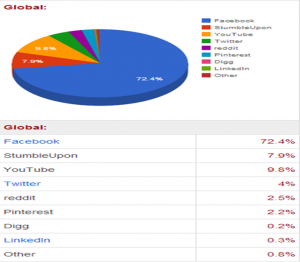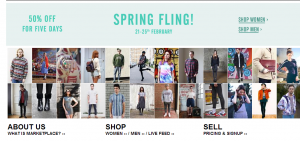Erik Qualman's Blog, page 638
April 8, 2013
Mobile Marketing: Which Social Network Will Win Your Advertising Dollars?


Mobile use is on the rise, and so are mobile advertising opportunities. The analyst firm Gartner estimates that this year, more people will use their mobile phones to access the Internet than they use their PCs, making it crucial for brands to be advertising in the mobile space. According to Gartner’s forecasts for mobile advertising, worldwide mobile ad revenues will top $11.4 billion in 2013, up 19 percent from 2012.
But where is the best place to put your mobile ad dollars? There are many options, particularly on social media. Facebook, Twitter and Google Plus, three of the largest social media platforms, offer advertising opportunities to reach their mobile users. There are also options for Windows Phone 8 operating system, though they are less-discussed and for this article, we’ll stick to the main three above.
Let’s take a look at the difference between mobile advertising on these three social media giants.
Facebook offers both cost per thousand impressions (CPM) and cost-per-click (CPC) campaigns that allow advertisers to choose their audience using demographics like location, age and gender. These mobile ads include images with text, and multiple ad versions can be used to see which one performs best, much like Google Adwords. Advertisers can choose to link their ad to their Facebook page (if your goal is to increase likes on your Facebook page) or directly to their website (if you’re aiming for immediate conversions). If you opt to send them directly to your website, be sure to track which sales are from Facebook.
Facebook recently revealed changes to the newsfeed that result in larger mobile ads. This is noteworthy for advertisers, because ads are now more prominent in users’ newsfeeds.
The Pros of Using Facebook Mobile Advertising
First and foremost, Facebook has more than 800 million users, so there’s no denying its reach. It collects specific information from users, so it can target advertising using a variety of demographics. Finally, it enables you to direct users to either your Facebook business page or your website.
The Cons of Using Facebook Mobile Advertising
One of the biggest drawbacks to advertising on Facebook is the lack of ability to customize your ads. Facebook has a format that all advertisers must use, which is an issue for advertisers that would like to use their own creative.
Twitter offers “promoted accounts” and “promoted tweets” for mobile advertisers. For promoted accounts, Twitter looks at your current followers and searches for people with similar interests. When it finds a match, it recommends your account in the “Who to Follow” section. For promoted tweets, Twitter monitors your engagement and automatically promotes your best tweets. You can also showcase your tweets publicly.
The Pros of Using Twitter Mobile Advertising
One of the best things about Twitter’s mobile advertisingis you don’t have to write ads or any new material. Twitter does the work for you, choosing the tweets that receive the most engagement. In addition, you only pay when someone follows you or engages with a promoted tweet.
The Cons of Using Twitter Mobile Advertising
Twitter’s advertising doesn’t target audiences to the extent Facebook does. And like Facebook, you cannot upload your own creative. The advertising options are simply promoted accounts and promoted tweets, both of which are formatted by Twitter. The ads also do not allow you to direct the users outside of the Twitter site, either; all interactions are conducted on Twitter.com.
Google Plus
Google Plus now offers mobile advertising, enabling businesses to advertise their Google Plus pages through AdWords Express. The use of AdWords Express makes advertising on Google Plus much different than advertising on Facebook and Twitter. On both Facebook and Twitter, you are advertising within the network and reaching only people who already interact on those platforms. AdWords Express enables businesses to drive potential customers to their Google Plus pages from outside the network. Ads will appear with other AdWords ads in Google search, maps and other Google properties.
The Pros of Using Google Plus Mobile Advertising
The most obvious benefit of mobile advertising on Google Plus is the ability to reach people outside of the Google Plus network. This means businesses can expand their reach on Google Plus without intrusive ads in users’ feeds. This also means these Google Plus pages are being promoted to people who are specifically searching for something related to your brand. This is in contrast to Facebook and Twitter, which can’t determine the intentions of users they are displaying ads to.
The Cons of Using Google Plus Mobile Advertising
The biggest drawback is that Google Plus hasn’t taken off with users like Facebook and Twitter have, so growth with it is slow.
The best place to spend your mobile ad dollars depends on your business’ specific goals, but one thing that is certain – people are increasingly consuming their media on the go, and if your business isn’t engaging them through mobile advertising, you risk being left behind.
[image error]
April 2, 2013
Optimizing for Mobile isn’t just for the Big Brands

 Small Businesses are realizing that mobile is meant for “today”, not “tomorrow” – and it’s time to get on board before falling behind. Mobile isn’t just about having an app (but it is one option). Being mobile can mean having a mobile site (or responsive design), an app that allows the consumer to interact with the brand, mobile payment options, and/or mobile advertisements. Where should your small business jump in? My advice – ensure you have a mobile site before anything else. Not sure? Consider how many of your target market use smart phones and how often they access your site through their mobile device over their laptop. If your site isn’t optimized for mobile, you are falling short.
Small Businesses are realizing that mobile is meant for “today”, not “tomorrow” – and it’s time to get on board before falling behind. Mobile isn’t just about having an app (but it is one option). Being mobile can mean having a mobile site (or responsive design), an app that allows the consumer to interact with the brand, mobile payment options, and/or mobile advertisements. Where should your small business jump in? My advice – ensure you have a mobile site before anything else. Not sure? Consider how many of your target market use smart phones and how often they access your site through their mobile device over their laptop. If your site isn’t optimized for mobile, you are falling short.
Easier than you Think: Building a mobile site can be as simple as converting your site to a mobile one – which allows your consumers to choose which one they use to view your site when they search for it via mobile. If your brand has a little more resources to commit – my vote is the responsive design. It conforms to whatever device your on immediately.
Ready to take the next step: A mobile app is not for every brand. An app should solve a need. One example would be a utility app or one that allows to shop the store through an app (ex. Amazon) rather than having to go to the site each time with your account.
Mobile Payment: Allowing consumers to pay with a mobile app is a great way to simplify things for a brand and for the consumer. The Small business and charity – Charity Water – does this well. They use Square in order to allow easy credit card payment on iPads, and also allowing consumers to feel secure about their transactions. Charity Water has been doing great things around the world, and being mobile friendly is key for them. They use mobile devices, mobile payment transactions, and social media such as Twitter which is imperative to their awareness and engagement.
Can’t forget Social: As seen by Charity Water, social networks like Twitter which are mainly done via mobile are key to not just awareness, but also promotion, content distribution, and engagement with a brand. Yes it takes resources, effort, strategy, and money – but it is essential to almost any small business.
Ads, Ads, and More Ads: Mobile ads are a whole other ball game and take a large amount of resources. It’s not a few hundred dollars a week like some google adword campaigns, but can cost at minimum 10s of thousands on a monthly basis. It takes a larger commitment, and is usually best after a small business is lucrative or has the backing to do so.
Small business – does not mean small mobile strategy. Small businesses can play like the big boys too.
Image source: http://www.toowaybroadband.co.uk/news...
[image error]
March 25, 2013
Mobilenomics Video

You and other fans asked for a mobile video infographic. So, we crunched the statistics and produced this Mobilenomics video. Let us know what your favorite mobile statistic is…
All the statistics and sources will be added to this post this week. Thanks for your patience.
[image error]
March 24, 2013
Social Media and Choosing a Hospital

Social media is here to stay, and hospitals are getting on board.
A 2012 study by Demi & Cooper and DC Interactive found that 41% of consumers used social media to help them decide which doctor or hospital to use. And hospitals are taking notice: According to the Mayo Clinic’s Health Care Social Media List, more than 1500 hospitals across the U.S. are using some form of social media.
So, how can you harness social media to choose your hospital?
Interact with Healthcare Providers
With more doctors joining social media every year, there’s a good chance your local physicians, and possibly your local hospital, are on your favorite networks. By following their social media profiles, you can keep up on your doctors’ research interests. Some doctors may even post information to help you manage your health or a specific condition.
Many hospitals and clinics are using social media to keep patients informed about current wait times, flu shot locations, and other notices. This can help you determine when to visit your clinic, so you don’t have to wait for hours to see a doctor.
Get Referrals
Your social networks can be a great source of referrals for hospitals. You can ask your friends which one they recommend, or run a search to find mentions of your hospital.
This is an excellent way to get a feel for how medical facilities and physicians in your area relate to their patients, and what level of care you can expect to receive.
If you have a chronic illness, you may be able to find a support group on social media. These groups can give you a place to share your story and learn about patients’ experiences with therapies provided by specific doctors and medical centers.
Look for Reviews
Social networks are also a great place to look for reviews. Many people will post their experiences with a medical center, physician, or specialist to their followers. By searching for your hospital or doctor’s name on your favorite network, you can look up what other people are saying.
While looking at these reviews, also pay attention to whether or not a hospital representative responds to them — particularly if the reviews are negative. The way a healthcare provider responds to negative feedback can tell you a lot about how they’ll treat you as a patient. If they’re consistently dismissive of reviewers, you may want to look elsewhere.
Just as your offline friends and family can help you decide on a hospital or doctor, your online social networks can provide word-of-mouth referrals and reviews.
Before making your final decision, try to look at the hospital’s online reputation as a whole.
Don’t take one patient’s negative (or positive) review as the entire story. Some doctor reviews will be honest, while others can certainly have a touch of bias to them.
Finding reviews from several different sources will give you a much clearer picture — and help you decide whether a particular hospital and/or doctor is the right medical provider for you.
Photo credit: suspensionortho.com
[image error]
March 20, 2013
Social Media: Best way to use Instagram for business promotion

Social media has become a global phenomenon among the web users, with almost everyone using the internet seems to have their accounts at site or the other. The sites like Facebook, Twitter, Google Plus, Instagram, Pinterest, etc. seem to have become the best tools for business promotion. Instagram is basically a photo sharing application for mobile users, which is now being acquired by Facebook by paying a whopping one billion dollars to the owners. Instagram has now being converted into a platform, which helps in communicating with people using images and acts like a social media platform, which has the potentials of building the brand for any business. More than hundred million users are seen being the part of Instagram community, thus giving you enough reason to use it for your business promotion. The below is the list of best ways to use Instagram for your business promotion and marketing.
Showcase your products or services
If you want to promote your business using Instagram, start capturing quality pictures of your products and upload them over this community. This will help in promoting the mobile window shopping using this tool, which displays an array of your products. Try snapping several pictures of your new products, to keep building up the buzz or simply focus on one product with different pictures of the same. Photos are the best medium to attract potential buyers and help in igniting the conversation, which engages them. If your business happens to be service oriented, showcase different equipment and supplies, which give the idea of the services you offer. For instance, you could think of putting your favourite workout gear if you deal in the fitness domain or put some impressive kind of lenses if in case you deal in photography business.
Build up the interest
Using Instagram simply to boost up the demands by showcasing your consumers’ new or creative methods to use your products would certainly spread the curiosity among the people seeing these pictures. You need to engage your followers by inviting through the content which interest your users and pose challenges before them to post pictures showcasing the creative applications of your products. And in case if you happen from the service industry, make sure you display the outcome your services have created by simply putting the before and after pictures. These ideas are best for industries dealing with fitness, auto body, make up, interior design, architecture and landscape designing. This will help in creating buzz and interest among your followers who come across these pictures.
Give your business brand a face
By showcasing your new and star employees and their achievements could help in your brand awareness among your target audience. This will therefore help in displaying your humility but at the same time could end up attracting a number of qualified consumers for any position, which you have earlier faced few problems in calling. When you start sharing your competent employees of different levels and positions along with putting their achievements and the number of celebrities connected brand, you could really make your brand more accessible to your target audience. In other words, you give a new face to your brand or enable the human presentation in it. Instagram has all the potentials of making this happen.
Build up a honey trap
By using Facebook and Twitter along with the Instagram could help in luring the people towards your brands. Facebook could be easily used with Instagram as it owns this platform, but now Twitter too could be harnessed to embark with ways to create honey trap to attract customers over it. At the same time, it is very much important to reward users who follow your brand over Instagram. This could be carried out by asking individual questions and posing different comments on their pictures. If you are keen to invite them to have good time with your brand then you are supposed to carry out these steps wisely and end up promoting your brand using this tool.
Organise Events and contests
Running Instagram campaign could help you in giving the insight about your business organization or company, which can help them to get a look into different departments of your company like factory floors, labs, production house, etc. This can help your followers to know where your products are made. You could ask the people to capture photos for your brand and in return you are supposed to reward them with a good price like even offering a good job position unlike the company GE did for a similar Instagram campaign for a person submitting a good quality photograph for the company as their Instagram Photographer.
Final word
The purpose of business marketing and promotion simply means communicating with your prospective customers. And unlike the other social media platforms, Instagram also plays an important role in promoting your business. All you need to do is to try above ways to use Instagram to promote your business.
About The Author: Kelly is a writer/blogger. She loves writing travelling and reading books. She contributes to Content Cloud
[image error]
March 18, 2013
Fashion’s Love Affair with Social Media

Social Media has become an integral part of every organisation’s marketing strategy. It has revolutionized brands marketing strategies and its approach to engaging with its public’s. The fashion industry seems to be at the pinnacle of this revolution. A recent info graphic created by Ebay shows the pivotal role social media plays within the fashion industry. Nowadays a fashion brands online presence is imperative to its success. The level of engagement a brand receives is dependent upon the content it creates and how effective it is at sharing/communicating this content across its relevant communication channels. Every fashion brand aims to create content that positions the brand in a space that reaches the masses that will either buy the product or inadvertently share the brands key messages across their social media channels.
The Reasons Why
These channels enhance and extend the brand experience for both current and future consumers. Twitter and Facebook allow brands to communicate with devoted followers who can amplify the brand’s message through their own networks.
Brands go where there followers go. This is a generic rule of thumb for all brands. It’s important to be actively involved where your customers and potential customers spend most of their time. Social networking is the in thing at the moment so it’s no surprise fashion enthusiasts spends a large proportion of their time online. The reason for this is that what you wear is inherently meant to be shared. It’s a representation of you — one that many like to broadcast out for all their friends to see. Lookbook.nu and Chictopia are examples of social fashion networks that highlight this fact.
Niche and high end fashion brands use Facebook and Twitter to converse with those in the mainstream market place and showcase the brand’s personality in a non-intrusive way. In a way making the brand more accessible to the general public who for the most part wouldn’t associate as it’s too expensive.
Social Media is a great place to show people what your business has to offer and to build brand awareness and direct fan engagement, but not sell the brand.Levi’s are one of the first fashion brand’s to use instagram, showcasing “levisbrasil” to display products that were not yet released in its upcoming collections.
A lot of fashion brands utilize blogging to communicate to their audience, typically promoting an aspect of their brand and then conversing with their audience in the form of comments below the article.
It’s a place where key influencers’ in the fashion world converse. Its important fashion brands are involved in conversations with influencers. It positions the brand and showcases that the brand has an opinion – essentially social media is the brand’s voice. For example if a discussion is going on about UGG boots and whether or not they should be worn in the summer. It’s important that you engage with your audience if UGG boots are a product that the brand is invested in.
The Top Ten
These fashion brands simply put the best at engaging with their public’s across social media channels. Each brand has millions of Facebook fans, Twitter followers and YouTube hits.
These brands all pump millions into campaigns for two reasons; to push the product and to allow the masses converse across social media channels; increasing brand engagement. These brands focus their time heavily on creating campaigns that can be broadcast, shared and talked about across YouTube, Facebook, Pinterest and Twitter –who hold 85 per cent of the social media market share.
The Trend Setters
These brands go the extra mile when it comes to innovation and creativity, using social media as a platform to differentiate and push there brand to the masses.
ASOS the leading online UK fashion store are a global leader when it comes to Social Media. They were one of the first to fully integrate the Facebook store, by launching the F-Commerce store in 2011. ASOS Marketplace encourages fashion and trends by allowing customers to sell pre-owned clothing or to sell their own-made clothes. They work really hard to build a community on the ASOS website: for example street-style photos are featured in a section of its blog by consumers or potential consumers, where they can vote, comment or buy them.
Burberry released its 2012 Spring/Summer Collection on Instagram and Twitter before it was seen on the runway. The show was also streamed live on its YouTube Channel. Burberry was also one of the first to adopt the Facebook timeline. To show its origin of 1856.
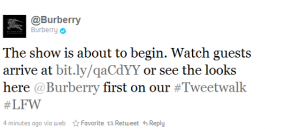
RueLaLa has adapted an exclusivity tactic through its Social Media profiles. The only way you can gain access to RueLaLa’s Facebook Page is through an invite or if you sign up to the Rue la la’s website. A risky but effective tactic resulting in over 22o,000 Facebook fans and moving away from the norm.
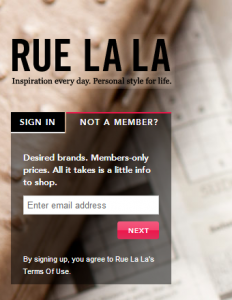
In summation, as these brands have shown the key to Social Media and Fashion’s relationship is that the brand produces creative content with the right mix of spontaneity and brand awareness,this will guarantee engagement among social followers.
[image error]
March 15, 2013
Can Social Media Improve Your Business Reputation?

 Whether you run a small or large business, fewer phone calls, less people walking in the front door, and a decline in your website traffic should signal to you that something is wrong. In some cases, terribly wrong.
Whether you run a small or large business, fewer phone calls, less people walking in the front door, and a decline in your website traffic should signal to you that something is wrong. In some cases, terribly wrong.
While you may be pointing to the challenging economy as to why your business has slowed down, that may be too easy of an answer. Do you think it could be that your business reputation may have been called into question?
With all that business owners finding themselves responsible for on a daily basis, it is not unheard of for them to fall a little behind in monitoring what is being said about them and/or their company online. When that happens, the trap can be very easy to fall into, that is just assuming that all is well in the online world.
Unless business owners are constantly monitoring what is being said about their brand online, they can find themselves with a nasty surprise or two when the fire starts to get a little hot. Before they know it, comments regarding their business (be they true or not) have taken on a life of their own. In such cases, social media can play a major role in turning things around.
With a determined and proven social media strategy, business owners can:
* Engage in real-time – One of the best facets of social media is that it can be done in real-time. Unlike the past where responding to customer needs or addressing negative comments may have meant hours or even days, you can use social media instantly. This is all the more reason why you need to monitor the online chatter regarding you and your business. If something negative is out there, you can use your Facebook, Twitter, Google+ accounts to address it. Always remember that time is of the essence when your business reputation is called into question;
* Educate consumers – Your social media tools are great vehicles in allowing you to educate both present and potential customers. With social media, you can provide consumers with links to tutorials, studies, analysis, and more. By doing this, consumers are more apt to come to you for information they need in determining the best products and services to meet their needs. If you have a Facebook fan page or Twitter account, use them to educate the masses, while at the same time enhancing your reputation as a proven leader in your industry;
* Network with other businesses – Another reason to use social media is networking with other businesses. In the event your business reputation is taking a hit, having a stable of supporters on social media can help you quell the fire. If both present and potential customers see other businesses coming to your side on social media, they are less likely to believe the negative comments that a customer or current/former employee said about you. Given the fact that any business can have its reputation called into question, having supporters out there makes the task of reclaiming your reputation less daunting.
Whether you do it yourself or seek the outside assistance of an Internet reputation management expert, those two options are certainly better than doing nothing.
As a business owner, has your reputation been called into question in the past?
If so, did you deploy social media to help better the situation?
Photo credit: 51blocks.com
[image error]
Facebook vs. Twitter: Know Whom You’re Writing For


It is quite common for Twitter and Facebook to get lumped together with nearly 25 other sites into a single category – social media. While there are definite similarities between the networks, there are far more differences.
When writing and sharing content, we must consider the audience of each platform. Knowing whom we are writing for will influence the word choice, formatting, and posting schedule.
By simply taking the same information and sharing it across a variety of social networks, the message will likely fall flat. Instead, customize your writing style for each target audience.
Social media is at the center of everyone’s online life. Whether writing for business or pleasure, let’s take a look at the differences between Facebook and Twitter.
User Demographics
As of December 31, 2012, Facebook boasts 1.06 billion active users. Of those, 618 million (just over half) check in daily.
By the end of 2012, 21% of the global internet population used Twitter on a regular basis. Each month, 288 million people sign in at least once.
The popularity of Facebook and Twitter differ by age ranges. Just over 30% of Facebook users are younger than 34. Meanwhile, 45% of users are over 45.
Alternately, Twitter has a much younger demographic. Nearly half of all users are under the age of 34 and only 30% are over 45.
A recent study found that between 2010 and 2012, the average age of Facebook users went up two years. Meanwhile, the average age of Twitter users when down in the same time frame.
When writing for the two different networks, it is important to take into consideration the age and size of the audience.
Twitter posts need to appeal to a younger crowd. Writing for Facebook should have a mature tone.
Some Facebook users don’t bother posting to Twitter because they feel the smaller audience doesn’t justify the effort. However, proponents of Twitter think size doesn’t matter. There are other benefits to posting on the social media superstar.
Relationships and Purposes
Facebook users connect with friends, family, colleagues and other acquaintances. They use the network to share commentary, post interesting content in the form of videos and photos, and engage in activities (like polls or games).
More importantly, most Facebook connections are founded in an offline relationship. This means users tend to have a stronger blond and greater degree of loyalty. Therefore, writing for Facebook usually has more influence.
While offline relationships are possible on Twitter, they aren’t as common. Therefore, the interactions on this social network tend to be less personal.
Twitter is used more as a listen exercise. Users listen in on what the target audience is discussing. That way, they can stay up-to-date on industry trends and give users what they want.
This social network is appealing to users because of the amazing search capabilities. Being able to segment content based on topic is a feature Facebook doesn’t offer. Twitter users take advantage of hashtags, trending topics, and saved searches.
By taking advantage of these tools, Twitter users have a larger circle of influence compared to Facebook.
Content Lifespan
It has been reported that nearly all the activity and engagements with Tweets happen within the first hour of posting. On the other hand, Facebook interactions can go on for hours or even days.
This means Facebook has a timeless quality about it. Posts are like an ongoing conversation – people will eventually get to it. When writing for Facebook, users should share information that will be just as relevant two or three weeks from now. Content writing doesn’t rely on time for effectiveness.
Meanwhile, Twitter users are worried about the here and now. They use the network for real-time communication. When writing for Twitter, share only the most pertinent, time sensitive information. Outdated news will be skipped – it was already covered by thousands of other people before you got around to it.
Getting Content Read
Because of Twitter’s real-time communication, it is important to post content several times per day. This helps reach as many users as possible because you have a better chance of posting while they are reading.
Facebook utilizes EdgeRank algorithm. This shows users the most relevant posts. EdgeRank determines relevancy by assessing the number of likes and comments a post receives. Therefore, to get seen by as many people as possible, you’ll need to post the most engaging, useful, relevant information for your target audience.
Does this mean you’ll need to spend a ton of time writing to meet the needs of your target audience? Not at all. Facebook users generally post one or two times per week. Twitter users post the same information several times per day. Neither strategy requires excessive writing – simply smart writing that is distributed at the optimal times.
Formatting Posts
Before sharing content on Twitter, take a close look at the post title. Twitter thrives on actionable phrases. If the post title doesn’t attract attention and demand action, consider pulling a single line from the article itself. Use this as the foundation of your Tweet.
Be aware of the character restriction when writing your Tweet. Make your Tweet easy to Re-Tweet. When adding the characters in your Twitter handle, the Re-Tweet still needs to be less than 140 characters. Therefore, your original post shouldn’t be more than 80 or 90 characters.
Also, be aware of your target audience’s primary interest. Try to include a keyword in your post that will appeal to them; then, turn the keyword into a hashtag to get even more followers.
Facebook doesn’t have a character restriction for posts. Take advantage of this. Play up your personal relationship with Facebook users. Write your post in a way that will build community. Try asking a question to get people talking.
Also, it is very important to consider the image in an article before linking to it on Facebook. A thumbnail of the article image will appear in the post. A good image makes the update stand out more. If your article doesn’t have an image, go back and add one.
Again, take your target audience into consideration when writing your update. Make sure your tone and focus match your audience.
While both Twitter and Facebook are found under the broad umbrella of social media, their uses and audiences are very different. Make sure you consider whom you are writing for before sharing content in either social network.
[image error]
March 13, 2013
10 of the Best iPhone Apps for Translating Languages

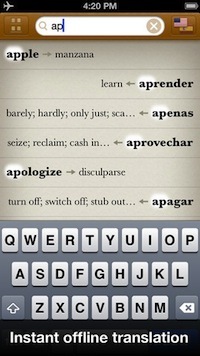 Language is a wonderful thing. It is the common thread that binds entire societies, allowing ease of communication and understanding. Finding yourself in a situation where you are unable to adequately communicate, on the other hand, is extremely frustrating. A language barrier can stunt relationships that could have grown stronger otherwise. Whether you are travelling abroad or seeking to learn a new language, the more tools you have at your disposal the better. With these 10 iPhone apps there is no reason you should ever find yourself lost for words again – regardless of the language.
Language is a wonderful thing. It is the common thread that binds entire societies, allowing ease of communication and understanding. Finding yourself in a situation where you are unable to adequately communicate, on the other hand, is extremely frustrating. A language barrier can stunt relationships that could have grown stronger otherwise. Whether you are travelling abroad or seeking to learn a new language, the more tools you have at your disposal the better. With these 10 iPhone apps there is no reason you should ever find yourself lost for words again – regardless of the language.
Languages – The name may not seem very imaginative, but the app certainly delivers on the promise. Languages is a $0.99 app that includes 12 full language dictionaries as of January 2013. The best feature of the app by far is the offline mode, which means you don’t need a connection to use the translator.
Google Translate – There are so many useful and fun features with Google Translate, it’s hard to believe that the app is free. You can use voice command for translations for over 15 languages, as well as listen to spoken translations in over 20 languages. There are also over 60 interchangeable languages available for text translation. The interface is simple to use and draws from Google’s vast resources to deliver accurate translations, including suggested alternatives for misspelled translations.
Universal Translator – With over 50 supported languages, this truly is a universal translator app. To use this app, both parties must have a Google Chat account, however, only one party needs to have the app installed. Once your mutual languages are defined, every message you type is automatically translated. This app costs $2.99 from the iPhone store.
iTranslate – As translator apps go, iTranslate is one of the most feature-packed offerings available. The basic app is free, but you can also purchase a powerful voice recognition add-on for $2.99. The Text-to-Speech feature is a lot of fun, too. You can enter any phrase, choose one of the many stored dialects, and the app will speak the phrase in that dialect. This feature includes both male and female voices, and you can slow down or speed up the output for better clarity.
SpeakText – This useful app will allow you to translate documents just by touching or highlighting text. The app will read out your chosen text sentence by sentence. There is a free version of the app available in the iPhone store, as well as a full version which is $9.99.
SayHi Translate – At $2.99, this app is well worth the money spent. It has incredibly accurate speech recognition in over 40 languages. The app combines language and dialect in order to return the best translation, helping you break down barriers in countries all over the world. SayHi Translate has been number one in both the App Store and Apple’s “What’s Hot.”
iProTranslate – Social media meets international relations with this $0.99 translator app. Use iProTranslate to communicate in over 40 languages via email, Twitter and Facebook. The interface is easy to use and returns quick results, so your conversations flow naturally without long delays in replying to your friends.
Voice Translate Pro – Speak languages in over 100 countries with this impressive voice translation app. The app is available for $2.99, which includes the full version of the app and all updates. Voice Translator Pro is constantly improving, so you won’t be disappointed with this extraordinary app.
MyLanguage Translator Pro – This app includes over 50 supported languages, which due to the community based nature of the app is sure to increase. MyLanguage actively encourages users to request new translations, as well as draws from a huge community of native speakers to improve current translations. Another excellent feature of this $4.99 app is the transliteration function, which can help translate Latin characters and aid in pronunciation.
Translate Professional – The free version of this app includes over 50 languages. However, you can purchase a number of add-ons, including speech recognition. The interface is incredibly easy to use and navigate, and the phrasebooks are available both on and offline. You can also hear the translated phrases spoken in the native language, giving you the chance to improve your language skills, too.
Armed with these 10 apps, you will never feel alone or unable to communicate in a foreign country again. These translators continue to improve, creating a global community where anyone can make new friends on an international scale without worrying about miscommunication along the way.
Source: http://www.aupairjobs.com/articles/10-of-the-best-iphone-apps-for-translating-languages/
[image error]
March 12, 2013
How to Showcase Tweets Publicly

Nowadays, most events are promoted through social media, and event organizers have discovered the power of associating a hashtag (#) with them. This allows people to comment on the event, and connect with other attendees before arrival – not to mention, it helps to promote the event online to a vast audience.
A great way to continue the conversation is to showcase the tweets live during the event on a big screen. Here I will share with you two websites that allow you to showcase a particular set of tweets in a visually appealing manner.
Visible Tweets
Visible Tweets allows you to type in a keyword, twitter handle or hashtag, and it will showcase various tweets containing your search in a marvelous way.
You can choose from three animation styles, including “letter by letter”, “rotation”, and “tag cloud”. All three animations are interesting, though my favourite is “rotation” (shown below).
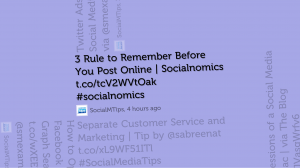
“Rotation” displays a tweet, and then rotates the screen to display the next tweet.
The displayed tweets showcase not only the tweet itself, but also the twitter handle of the person that tweeted it and how long ago the tweet was posted. This allows the guests at your event to communicate with other guests, share thoughts about the event, and discover what other people are saying about the event as it happens.
TweetBeam
TweetBeam showcases tweets in a very different manner than Visible Tweets, but in a just as appealing fashion. After searching for a particular topic or hashtag, TweetBeam showcases multiple profile photos on the page, and then highlights a particular photo while displaying the tweet.
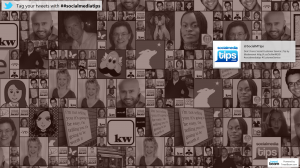
Including #socialmediatips in your tweet would allow you to appear in this TweetBeam.
TweetBeam also highlights what was searched for (shown in the top left of the image), so everyone will know what to include in their tweet to make it appear on the screen.
Why You Should Showcase Tweets Live
When attendees see their tweets on a big screen that the entire audience can see, they feel much more involved in the event. They will be much more likely to continue to tweet the associated hashtag, and will appreciate feeling more engaged.
One thing to remember is that you don’t want the screen of tweets to be the main attraction of the event. When keynote speakers are on stage, consider turning off the screen of tweets until they are finished, or you could display the speaker’s personal social media information on the screen instead. The audience will then be able to mention the speaker in their tweets, and once the screen of tweets is back up, they will be able to share what they thought of the speech with the rest of the audience.
REMEMBER: if you are associating a hashtag with your event, research the hashtag first! You do not want tweets showing up on a big screen at your event that aren’t associated with it, or worse, contain vulgar language that may offend those who are in attendance.
So, the next time you are hosting an event, start encouraging possible attendees to use your hashtag early to gain some hype then use one of these tools to display relevant tweets live during the event in an eye-catching manner, and watch your audience become engaged!
For more social media tips and tricks, check out SocialMediaTips.com.
Author: Sabreena Thouli
Have you ever used a hashtag that was being used already for something completely different? Share your answer, and any other comments, below.
[image error]




